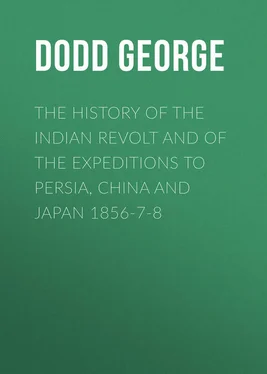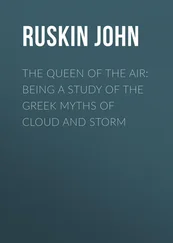George Dodd - The History of the Indian Revolt and of the Expeditions to Persia, China and Japan 1856-7-8
Здесь есть возможность читать онлайн «George Dodd - The History of the Indian Revolt and of the Expeditions to Persia, China and Japan 1856-7-8» — ознакомительный отрывок электронной книги совершенно бесплатно, а после прочтения отрывка купить полную версию. В некоторых случаях можно слушать аудио, скачать через торрент в формате fb2 и присутствует краткое содержание. Жанр: foreign_antique, foreign_prose, на английском языке. Описание произведения, (предисловие) а так же отзывы посетителей доступны на портале библиотеки ЛибКат.
- Название:The History of the Indian Revolt and of the Expeditions to Persia, China and Japan 1856-7-8
- Автор:
- Жанр:
- Год:неизвестен
- ISBN:нет данных
- Рейтинг книги:3 / 5. Голосов: 1
-
Избранное:Добавить в избранное
- Отзывы:
-
Ваша оценка:
- 60
- 1
- 2
- 3
- 4
- 5
The History of the Indian Revolt and of the Expeditions to Persia, China and Japan 1856-7-8: краткое содержание, описание и аннотация
Предлагаем к чтению аннотацию, описание, краткое содержание или предисловие (зависит от того, что написал сам автор книги «The History of the Indian Revolt and of the Expeditions to Persia, China and Japan 1856-7-8»). Если вы не нашли необходимую информацию о книге — напишите в комментариях, мы постараемся отыскать её.
The History of the Indian Revolt and of the Expeditions to Persia, China and Japan 1856-7-8 — читать онлайн ознакомительный отрывок
Ниже представлен текст книги, разбитый по страницам. Система сохранения места последней прочитанной страницы, позволяет с удобством читать онлайн бесплатно книгу «The History of the Indian Revolt and of the Expeditions to Persia, China and Japan 1856-7-8», без необходимости каждый раз заново искать на чём Вы остановились. Поставьте закладку, и сможете в любой момент перейти на страницу, на которой закончили чтение.
Интервал:
Закладка:
The last acts of the Cawnpore tragedy now await our attention.
What horrors the poor women suffered during their eighteen days of captivity under this detestable miscreant, none will ever fully know; partial glimpses only of the truth will ever come to light. According to the ayah’s narrative, already noticed, the women and children who were conveyed from the boats into captivity were a hundred and fifteen in number. The poor creatures (the women and elder girls) were sought to be tempted by an emissary of the Nena to enter quietly into his harem; but they one and all expressed a determination to die where they were, and with each other, rather than yield to dishonour. They were then destined to be given up to the sensual licence of the sepoys and sowars who had aided in their capture; but the heroic conduct of Sir Hugh Wheeler’s daughter is said to have deterred the ruffians. What this ‘Judith of Cawnpore’ really did, is differently reported. Her heroism was manifested, in one version of the story, by an undaunted and indignant reproach against the native troops for their treachery to the English who had fed and clothed them, and for their cowardice in molesting defenceless women; in another version, she shot down five sepoys in succession with a revolver, and then threw herself into a well to escape outrage; in a third, given by Mr Shepherd, this English lady, being taken away by a trooper of the 2d native cavalry to his own hut, rose in the night, secured the trooper’s sword, killed him and three other men, and then threw herself into a well; while a fourth version, on the authority of the ayah, represents the general’s daughter as cutting off the heads of no less than five men in the trooper’s hut. These accounts, incompatible one with another, nevertheless reveal to us a true soldier’s daughter, an English gentlewoman, resolved to proceed to any extremity in defence of her own purity.
The victims were detained three days at Nena’s camp, with only a little parched grain to eat, dirty water to drink, and the hard ground to lie upon, without matting or beds of any kind. The ayah states that the Nena, after the events of the 27th of June, sent to ask the temporarily successful King of Delhi what he should do with the women and children; to which a reply was received, that they were not to be killed. Whether this statement be right or wrong, the captives were taken from the camp to Cawnpore, and there incarcerated in a house near the Assembly Rooms, consisting of outbuildings of the medical depôt, shortly before occupied by Sir George Parker. Here they were joined by more than thirty other European women and children, the unhappy relics of the boat-expedition that had been recaptured near Futtehpoor in the vain attempt to escape. Without venturing to decide whether the ayah, Nujoor Jewarree, Mr Shepherd, or Lieutenant Delafosse was most nearly correct in regard of numbers; or whether Sir Hugh Wheeler was at that time alive or dead – it appears tolerably certain that many unhappy prisoners were brought back into Cawnpore on the 1st of July. All the men were butchered in cold blood on the evening of the same day. One officer’s wife, with her child, clung to her husband with such desperate tenacity that they could not be separated; and all three were killed at once. The other women were spared for the time. This new influx, together with five members of the Greenway family, swelled the roll of prisoners in the small building to a number that has been variously estimated from a hundred and fifty to two hundred, nearly all women and children. Their diet was miserably insufficient; and their sufferings were such that many died through want of the necessaries of life. ‘It is not easy to describe,’ says Mr Shepherd, ‘but it may be imagined, the misery of so many helpless persons: some wounded, others sick, and all labouring under the greatest agony of heart for the loss of those, so dear to them, who had so recently been killed (perhaps before their own eyes); cooped up night and day in a small low pukha-roofed house, in the hottest season of the year, without beds or punkahs, for a whole fortnight – and constantly reviled and insulted by a set of brutish ruffians keeping watch over them.’
Added to all these suffering women and children, were those belonging to the second boat-expedition from Futteghur. It will be remembered, from the details given in a former page, that one party from this fort reached Bithoor about the middle of June, and were at once murdered by orders of Nena Sahib; while another body, after a manly struggle against the rebels for two or three weeks, did not prosecute their voyage downwards until July. It will throw light on the perils and terrors of these several boat-adventures to transcribe a few sentences from an official account by Mr G. J. Jones, a civil servant of the Company, who left Futteghur with the rest on the 4th of July, but happily kept clear of the particular boat-load which went down to Cawnpore: ‘We had not proceeded far, when it was found that Colonel Goldie’s boat was much too large and heavy for us to manage; it was accordingly determined to be abandoned; so all the ladies and children were taken into Colonel Smith’s boat. A little delay was thus caused, which the sepoys took advantage of to bring a gun to bear on the boats; the distance, however, was too great; every ball fell short. As soon as the ladies and children were all safely on board, we started, and got down as far as Singheerampore without accident, although fired upon by the villagers. Here we stopped a few minutes to repair the rudder of Colonel Smith’s boat; and one out of the two boatmen we had was killed by a matchlock ball. The rudder repaired, we started again, Colonel Smith’s boat taking the lead; we had not gone beyond a few yards, when our boat grounded on a soft muddy sand-bank; the other boat passed on; all hands got into the water to push her; but, notwithstanding all our efforts, we could not manage to move her. We had not been in this unhappy position half an hour, when two boats, apparently empty, were seen coming down the stream. They came within twenty yards of us, when we discovered they carried sepoys, who opened a heavy fire, killing and wounding several. Mr Churcher, senior, was shot through the chest; Mr Fisher, who was just behind me, was wounded in the thigh. Hearing him call out, I had scarcely time to turn round, when I felt a smart blow on my right shoulder; a bullet had grazed the skin and taken off a little of the flesh. Major Robertson was wounded in the face. The boats were now alongside of us. Some of the sepoys had already got into our boat. Major Robertson, seeing no hope, begged the ladies to come into the water rather than fall into their hands. While the ladies were throwing themselves into the water, I jumped into the boat, took up a loaded musket, and, going astern, shot a sepoy… Mr and Mrs Fisher were about twenty yards from the boat; he had his child in his arms, apparently lifeless. Mrs Fisher could not stand against the current; her dress, which acted like a sail, knocked her down, when she was helped up by Mr Fisher… Early the next morning a voice hailed us from the shore, which we recognised as Mr Fisher’s. He came on board, and informed us that his poor wife and child had been drowned in his arms.’
The occupants of the boat that prosecuted the voyage down to Cawnpore, or rather Bithoor, suffered greatly: the hands of the gentlemen who were on board, and who pulled the boat, were terribly blistered; the women and children suffered sad hardships; and all were worn down by fatigue and anxiety. At Bithoor, so far as the accounts are intelligible, Nena Sahib’s son seized the boat, and sent all the unfortunate Europeans in her into confinement at Cawnpore. As in other parts of this mournful tragedy, it will be vain to attempt accuracy in the statement of the numbers of those that suffered; but there is a subsidiary source of information, possessing a good deal of interest in connection with the July occurrences. When, at a later date, the reconquerors of Cawnpore were in a position to attempt a solution of the terrible mystery; when the buildings of Cawnpore were searched, and the inhabitants examined, for any documents relating to the suffering Europeans – a paper was found, written in the Mahratta language, in the house of a native doctor who had been in charge of the prisoners, or some of them. It was, or professed to be, a list of those who were placed under his care on Tuesday the 7th of July; but whether invalids only, does not clearly appear. All the names were given, with some inaccuracy in spelling; which, however, cannot be considered as rendering the document untrustworthy. In it were to be found large families of Greenways, Reids, Jacobis, Fitzgeralds, Dempsters, and others known to have been in Cawnpore about that time. They were a hundred and sixty-three in number. To this hapless group was added another list, containing the names of forty-seven fugitives belonging to the second boat-party from Futteghur, who are reported as having arrived on the 11th of July, and who included many members of the families of the Goldies, Smiths, Tuckers, Heathcotes, &c., already named in connection with the Futteghur calamities. The Mahratta document gave altogether the names of two hundred and ten persons; but it was silent on the question how many other Europeans were on those days in the clutches of the ruthless chieftain of Bithoor. A further list contained the names of about twenty-six persons, apparently all women and children, who died under this native doctor’s hands between the 7th and the 15th, diminishing to that extent the number of those left for massacre. To most of the names ‘cholera,’ or ‘diarrhœa,’ or ‘dysentery’ was appended, as the cause of death; to two names, ‘wounds;’ while one of the patients was ‘a baby two days old.’ In what a place, and under what circumstances, for an infant to be born, and to bear its two wretched days of life!
Читать дальшеИнтервал:
Закладка:
Похожие книги на «The History of the Indian Revolt and of the Expeditions to Persia, China and Japan 1856-7-8»
Представляем Вашему вниманию похожие книги на «The History of the Indian Revolt and of the Expeditions to Persia, China and Japan 1856-7-8» списком для выбора. Мы отобрали схожую по названию и смыслу литературу в надежде предоставить читателям больше вариантов отыскать новые, интересные, ещё непрочитанные произведения.
Обсуждение, отзывы о книге «The History of the Indian Revolt and of the Expeditions to Persia, China and Japan 1856-7-8» и просто собственные мнения читателей. Оставьте ваши комментарии, напишите, что Вы думаете о произведении, его смысле или главных героях. Укажите что конкретно понравилось, а что нет, и почему Вы так считаете.












